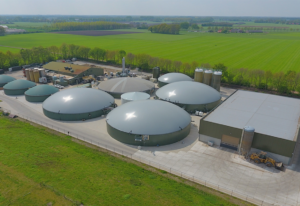Groot Zevert, The Netherlands – demonstration plant

Visit their website, read their factsheet, explore an illustration of the technology, process and products and watch the video – available in English and Dutch.
Plant description: Groot Zevert Vergisting (GZV, Beltrum) operates an anaerobic digester and NRR installation turning 71,000 tonnes of pig manure and 23,000 tonnes of residues from agro-food industry into biogas and biobased fertilising products. GZV is located in a region where farmers have an urgent need to find sustainable solutions for the surplus of animal manure which cannot be applied on land within the application limits for phosphorus (P) and nitrogen (N). Until 2019, GZV exported hygienised digestate to Germany over distances of 250 km. Their goal is to offer a sustainable solution of the surplus of manure avoiding long-distance transport of liquid manure.
Innovations: GZV has invested in two installations: Digestate is separated into a solid and liquid fraction by means of a decanter centrifuge. The liquid fraction is further processed by means of micro-filtration and reverse osmosis (RO) into a concentrate and clean water. Water is further purified on an ionic exchanger prior to being discharged onto surface water. The solid fraction is either exported to Germany as an organic phosphorus fertiliser or further treated in the RePeat system: This involves separation of the solid fraction into an organic soil improver and a precipitated P salt through a process using sulphuric acid and lime. This is the first full-scale installation for separation and recovery of P from digestate.
Mass- and Energy balances:
- In 2020, GZV produced 104 m3 biogas per of feedstock of which 70% was sold to a nearby dairy factory corresponding to 33,000 MWh of energy. Electricity and heat demand of the digester and digestate treatment installations are fully covered by energy generated from the remaining 30% of the biogas. The remainder of 1,800 MWh of electricity was fed to the national grid.
- The GENIUS installation converted one tonne of digestate into 0.15 tonnes solid fraction, 0.25 tonnes RO concentrate, 0.45 tonne of sludge and 0.15 tonnes dischargeable water. Sludge includes concentrate of the microfiltration unit and is disposed as animal manure within the Netherlands. GZV is still looking into possibilities to decrease volume of sludge and increase production of water as this would benefit the business case of the installatio
- The RePeat installation effectively reduced the phosphorus content of the solid fraction by 85%. Phosphorus was recovered as a calcium-phosphate sludge with a dry matter content of 17%. Further optimisation is needed to produce a stackable P fertiliser that can be sold to the fertiliser industry.
End-products & Agronomic quality:
- RO concentrate contains 8 g N/kg as ammonium and complies with RENURE criteria, meaning that is a suitable alternative for synthetic N fertilisers. The product is prone to ammonia emissions and injection into the soil is therefore mandatory. A blend of RO concentrate and other N fertilisers has been tested in field trials as part of the pilot project ‘biobased fertilisers Achterhoek’.
- Production of RO concentrate coincides with production of side products (sludges) having a low Nitrogen Fertiliser Replacement Value (NFRV)
- Solid fraction of digestate has a dry matter content of 30% and is exported to Germany or further treated to remove phosphorus.
- The low-P soil improver, consisting of 80% organic matter, can be used as a source of organic matter for sandy soils in the region of the plant. Sulphur content is enriched and farmers should take this into account in their fertilisation scheme.
- Thanks to its high water-holding capacity, the low-P fibres may also be a suitable alternative for peat in potting soil or substrate.
Environmental benefits:
- Energy consumption of digestate treatment is compensated by the 55% decrease in transport of digestate-derived products.
- Methane emissions from slurry pits are avoided by anaerobic digestion of animal manure.
Business Case:
- GZVs business case has a solid base due to the sale of biogas and electricity. This is driven by the intake of co-products that are responsible for 80% of the biogas production.
- Though technically possible, production of tailor-made fertilising products (i.e. RENURE product, organic fibres) does not necessarily improve the business case.
- The future supply of animal manure and support schemes for biogas production from co-digestated manure are still uncertain. The number of livestock animals and hence the manure surplus is decreasing due to state measures. On the other hand, there is a growing awareness of the environmental benefits of manure treatment, but this is not yet financially rewarded.
Outlook:
- A higher production of water and lower production of side streams are needed to reduce the costs and to compete with disposal costs for non-treated manure.
- To improve the business case, GZV will further invest possibilities to adjust the RePeat process in order to produce fibres for use in potting soil or substrate. This involves a shift from focussing on P removal towards production of low-salt organic fibres. However, there is a growing interest in peat replacers, market acceptance may still be an obstacle.
- In general, GZVs future steps will depend on changes in the manure market and legislation in relation to biogas production and manure treatment; both are yet uncertain.

